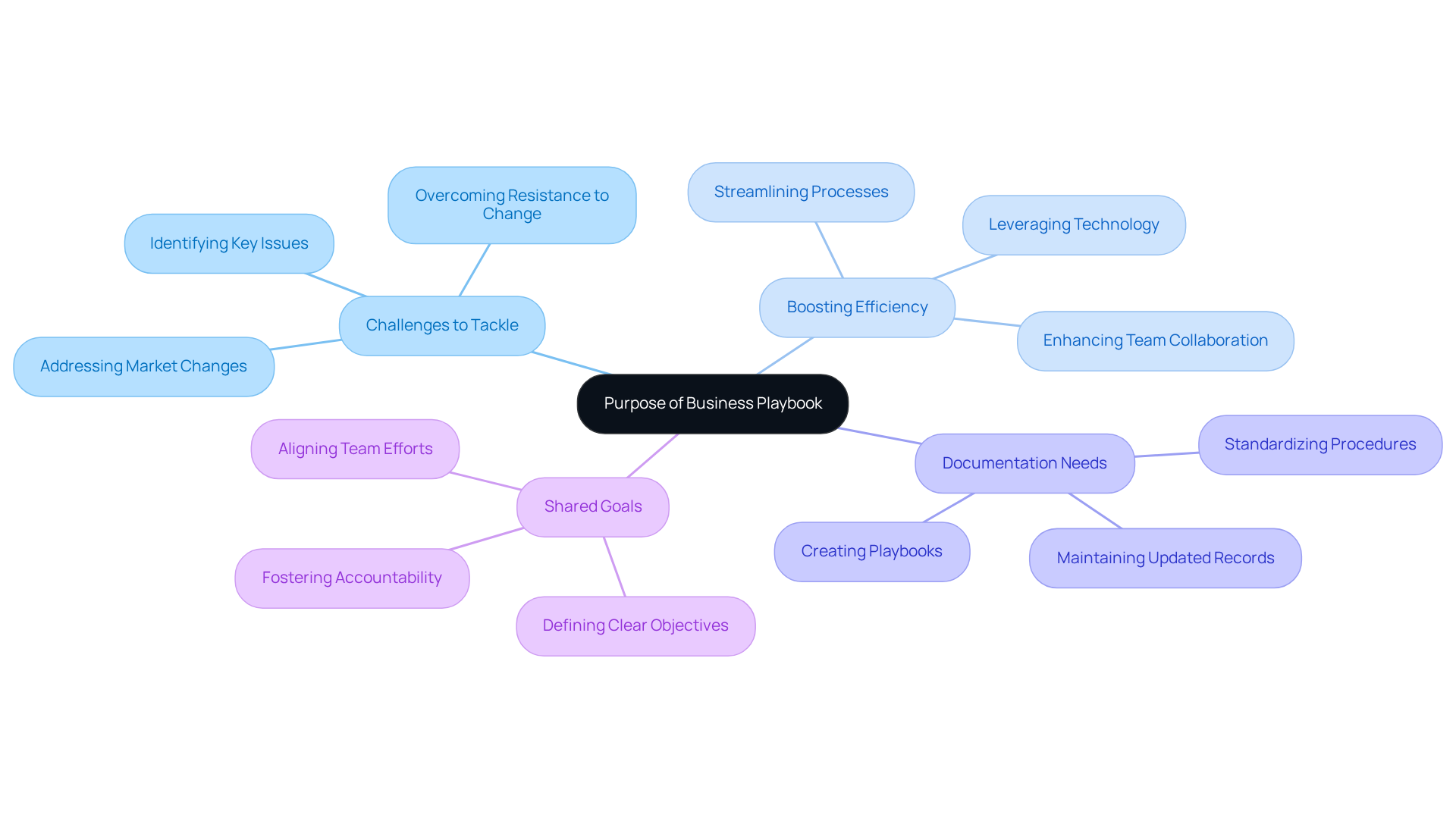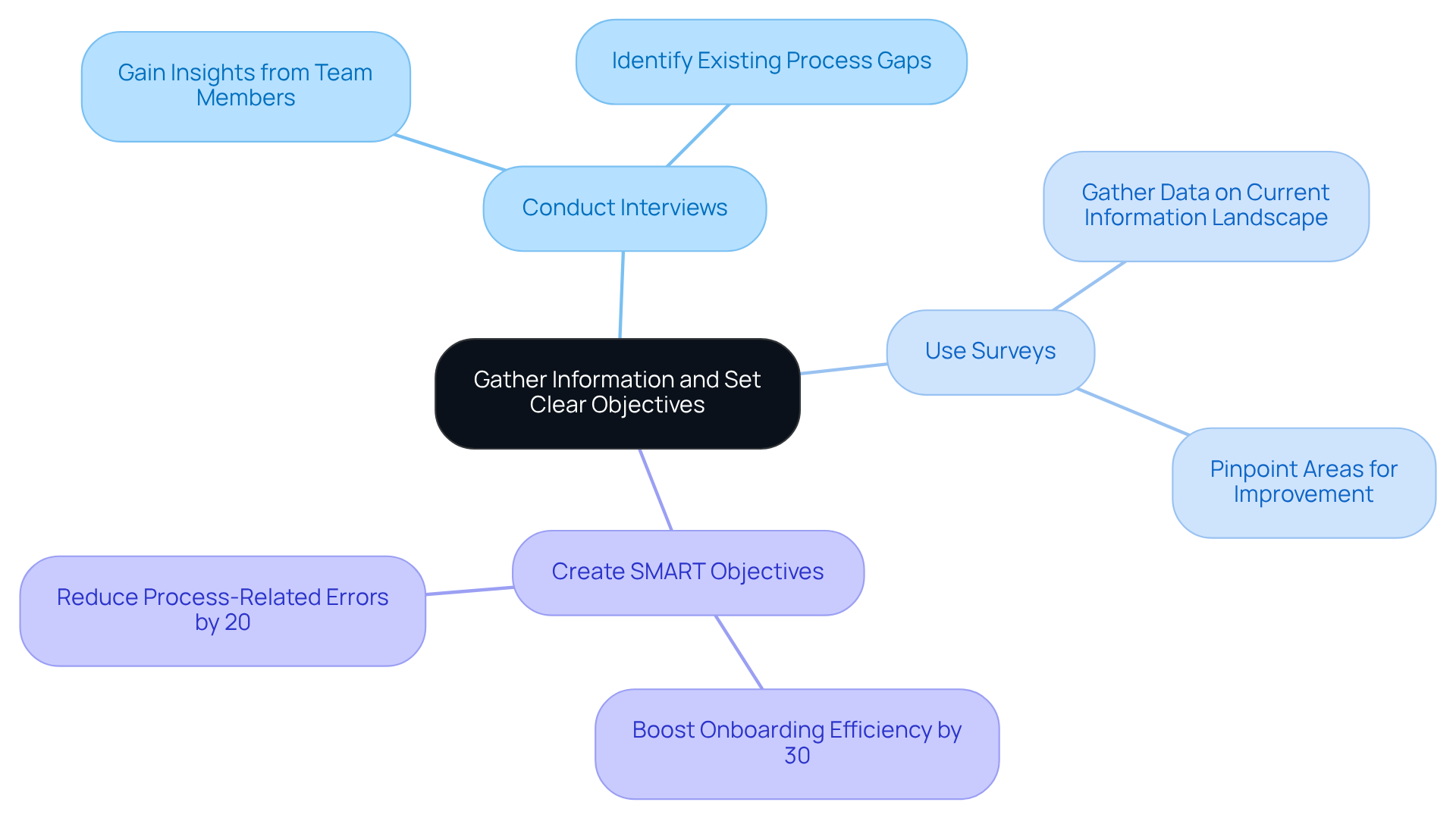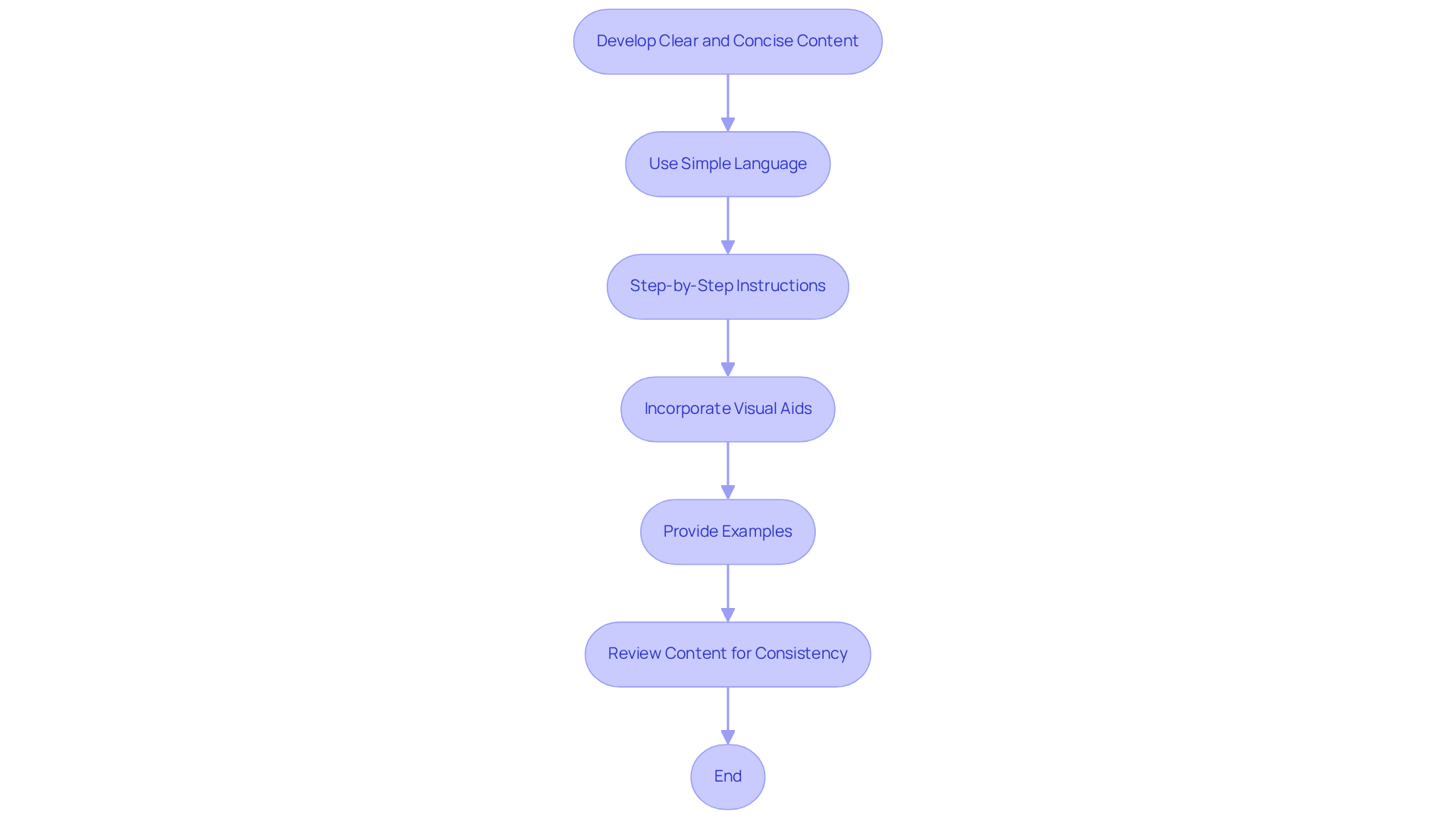
Knowledge Management through Documentation
|
October 17, 2025
|
5 Steps for Creating Playbooks That Streamline Operations
Overview
Creating effective playbooks that streamline operations is all about defining the playbook's purpose. You might be wondering how to get started? Well, it involves gathering insights, structuring content clearly, and developing concise instructions. Plus, don’t forget about implementing training for your team members! This article dives into each step in detail, emphasizing just how crucial clarity and usability are in documentation.
Speaking of that, let’s highlight the benefits of structured training sessions—they're key to enhancing team alignment and boosting operational efficiency.
So, are you ready to explore how these elements can transform your processes?
Key Highlights:
- Define the purpose of the business playbook by identifying specific challenges and goals to foster team alignment and accountability.
- Gather insights through interviews and surveys, and set SMART objectives to enhance operational efficiency.
- Structure the playbook with clear sections such as introduction, processes, roles, and policies to ensure usability and clarity.
- Develop concise content using simple language, step-by-step instructions, and visual aids to improve understanding and retention.
- Implement the playbook with thorough training sessions that cover its purpose, navigation, and essential processes, while encouraging feedback for continuous improvement.
Introduction
Creating effective playbooks is super important for businesses looking to boost their operational efficiency and get everyone on the same page. You might be wondering how outlining clear objectives and structured content can really make a difference. Well, it helps organizations streamline processes, cut down on errors, and ramp up overall productivity. But what happens when teams find it tough to adopt these guides, or when the playbooks themselves feel like a chore? Now, let’s dive into five crucial steps for crafting playbooks that not only hit the mark but also engage and empower teams to reach their goals together.
- Define clear objectives
- Structure content effectively
- Include practical examples
- Make it visually appealing
- Encourage feedback and updates
Define the Purpose of Your Business Playbook
Let's kick things off by gathering your group to chat about the big goals of your business strategy. You might be wondering about a few key questions:
- What specific challenges are we looking to tackle?
- How can this guide boost our group's efficiency and benefit the organization overall?
- Which processes or knowledge areas need some documentation love?
Getting a clear grasp of the guide's purpose is super important. So, jot it down succinctly—it'll act as your guiding star throughout the development process. A well-defined purpose not only gets your team on the same page but also fosters accountability, ensuring everyone is laser-focused on hitting those shared goals. At SowFlow, we’ve got tools that help you keep this documentation process systematic, which is essential for creating playbooks that are always fresh and integrated into your company. Remember, organizations with a strong sense of purpose are in a better spot to spark innovation and achieve long-term growth. So, let’s dive into this together!

Gather Information and Set Clear Objectives
You might be wondering where to start when it comes to improving your processes. A great first step is to conduct interviews with your group members. This way, you can gain valuable insights into the existing processes. Also, consider using surveys or questionnaires to gather data on the current information landscape and pinpoint any gaps.
Now, let’s dive into creating playbooks that include some SMART objectives—Specific, Measurable, Achievable, Relevant, and Time-bound. For example, how about aiming to boost onboarding efficiency by 30% in just six months? Or maybe you want to reduce those pesky process-related errors by 20% in the next quarter? Whatever you choose, creating playbooks to document these objectives clearly will ensure your team remains aligned and focused.
Did you know that studies show firms with structured onboarding processes can increase new hire productivity by a whopping 70%? That really highlights how important clear objectives are for achieving operational excellence. Plus, companies that nail their onboarding see 33% more staff feeling engaged compared to those that don’t—talk about the power of effective guidelines on overall business performance!
Let’s not forget the case studies that reveal companies with clear role guidelines enjoy improved retention rates. Just look at the 'Retention Rates Linked to Onboarding Processes' study, which illustrates the positive outcomes of structured onboarding. As experts say, 'Employee onboarding represents one of the highest-impact investments organizations can make in their workforce.' So, what are you waiting for? Let's get started on crafting those clear objectives!

Structure Your Playbook for Clarity and Usability
Creating an effective operational guide? You might be wondering where to start! Begin by outlining its main sections to ensure everything is clear and easy to use. Common sections you’ll want to include are:
- Introduction: This is where you give an overview of the playbook's purpose and objectives, setting the stage for users.
- Processes: Here, you’ll provide detailed descriptions of key workflows, making sure each step is clearly defined.
- Roles and Responsibilities: It’s crucial to clarify who’s responsible for what—this helps prevent confusion and enhances accountability.
- Policies: Don’t forget to include guidelines and standards that must be followed, ensuring compliance and consistency.
Using headings, subheadings, and bullet points can significantly boost readability, making the content scannable. A table of contents? That’s a game changer for easy navigation, allowing users to quickly find what they need.
Now, let’s talk about clarity in documentation—it’s super important! As George Bernard Shaw wisely said, "The single biggest problem in communication is the illusion that it has taken place." This really highlights the need for straightforward and accessible material in guides. Plus, did you know that 86% of users look for more information about a site's products and services after landing on a homepage? That just underscores the demand for clear and comprehensive documentation.
Incorporating usability principles into your design framework is key. Research shows that 79% of users will search for another website if they can’t find what they’re looking for. That’s a strong reminder of the need for functional and user-friendly documents. Well-organized manuals, like those used by top organizations, contribute to creating playbooks that simplify operations and boost team cooperation and effectiveness, leading to enhanced performance. So, let’s make those guides work for you!

Develop Clear and Concise Content
When you're creating playbooks, it’s all about keeping things clear and concise. You might be wondering how to do that—well, using simple language and avoiding jargon can really help everyone understand better. Each section should include:
- Step-by-step instructions for processes, making it easy for users to follow along.
Creating playbooks can include using visual aids like flowcharts or diagrams to simplify complex workflows. Did you know that studies show folks perform tasks 323% better when they have visuals to guide them instead of just written instructions? This is super important in fast-paced environments where every detail counts.
Creating playbooks that include relevant examples or case studies can give context and showcase successful implementations.
Creating playbooks requires regularly reviewing your content for consistency in tone and style, which is key to aligning with your earlier objectives. Plus, incorporating visuals not only helps with understanding but also boosts retention significantly; people remember 42% more information when it’s presented visually rather than just in text. By weaving these elements into your strategy, you’ll make it not only more engaging but also more effective at streamlining operations. So, let’s get started on making your playbook shine!

Implement and Train Your Team on the Playbook
Once your strategy document is finalized, you might be wondering how to get your team on board. It's crucial to arrange a thorough training session for your group! This session should cover some key elements:
- The purpose of the playbook and its benefits, highlighting how it streamlines operations and enhances productivity.
- Navigation methods for the guide, ensuring team members can easily find the information they require.
- A summary of essential processes and policies recorded within the guide, emphasizing their significance in daily operations.
Now, let’s dive into creating an engaging atmosphere! Welcome inquiries and offer practical experience with the guide. Did you know that research indicates employees trained through gamification are 48% more likely to complete courses and retain information longer than those using traditional methods? So, it’s definitely beneficial to incorporate engaging training techniques!
To foster continuous improvement, establish a feedback loop where team members can suggest enhancements or report any issues they encounter. Organizations that implement effective feedback mechanisms see a significant increase in employee engagement and productivity, making creating playbooks a crucial step for successful implementation. Plus, 90% of HR managers believe training benefits employee productivity and development, underscoring the importance of a well-structured training session.

Conclusion
Creating effective playbooks is super important for streamlining operations and boosting productivity in your organization. You might be wondering how to get started. Well, it all begins with:
- Clearly defining the purpose of the playbook
- Gathering the right information
- Structuring content for usability
- Developing concise, clear instructions
Plus, implementing comprehensive training helps cultivate a culture of efficiency and accountability. Each step not only builds a solid guide but also aligns your team toward shared goals, driving success together.
Throughout the article, we’ve highlighted the need to understand the specific challenges your team faces and the value of setting SMART objectives. By thoughtfully structuring your playbook and adding user-friendly elements, you can make sure your guides are not just informative but also engaging. And let’s not forget about training and continuous feedback—these are key to enhancing employee engagement and ensuring everyone retains the information, ultimately leading to better performance.
So, in wrapping things up, developing and implementing business playbooks is crucial for navigating operational challenges and hitting your strategic goals. I encourage you to take actionable steps in crafting your playbooks, making sure they’re clear, concise, and tailored to your team’s needs. By doing this, you’ll not only streamline operations but also foster an environment of collaboration and innovation, empowering your employees to shine.
Frequently Asked Questions
What is the purpose of a business playbook?
The purpose of a business playbook is to define the big goals of a business strategy, tackle specific challenges, boost group efficiency, and document important processes or knowledge areas.
Why is it important to have a well-defined purpose for a playbook?
A well-defined purpose ensures the team is aligned, fosters accountability, and keeps everyone focused on shared goals, which can lead to innovation and long-term growth.
What are some methods to gather information for creating a playbook?
Methods include conducting interviews with group members, using surveys or questionnaires to gather data on existing processes, and identifying any gaps in the current information landscape.
What are SMART objectives, and why are they important?
SMART objectives are Specific, Measurable, Achievable, Relevant, and Time-bound goals that help ensure the team remains aligned and focused on improving processes, such as boosting onboarding efficiency or reducing errors.
How can structured onboarding processes impact new hire productivity?
Studies show that firms with structured onboarding processes can increase new hire productivity by up to 70% and lead to higher employee engagement and retention rates.
What are the benefits of having clear role guidelines in a business?
Clear role guidelines can improve retention rates and enhance overall business performance, as evidenced by case studies linking structured onboarding to positive outcomes for organizations.
👍
What others are liking
5 Steps to outline your ideal documentation structure
5 MINS READ
Where to start the your journey of mapping out your ideal documentation structure, aligning it with the very heartbeat of your organization?
Defining a winning level of detail in your process
3 MINS READ
What is too much detail, and what is too little? This article described in that winning level detail about what detail is enough.





